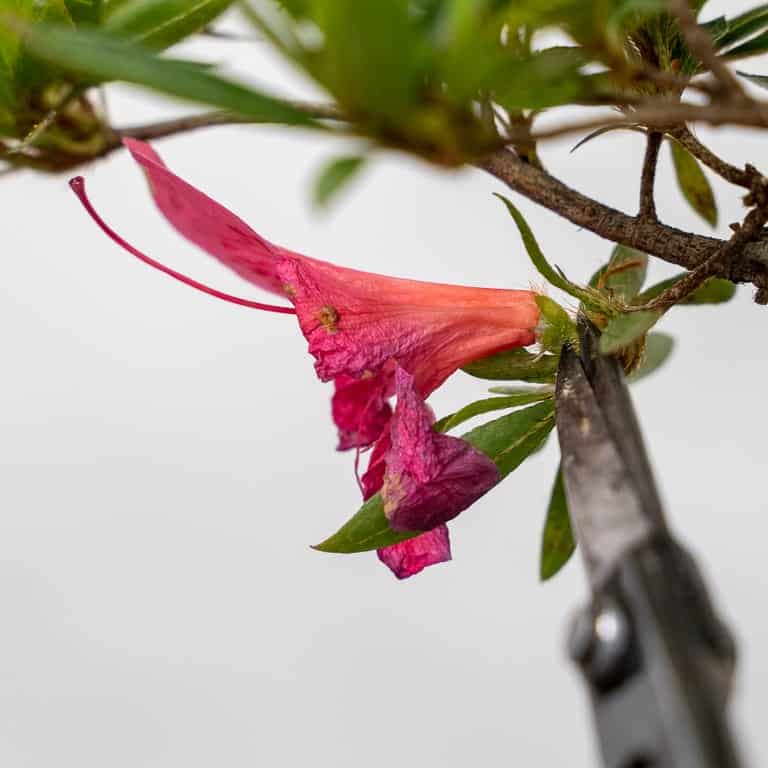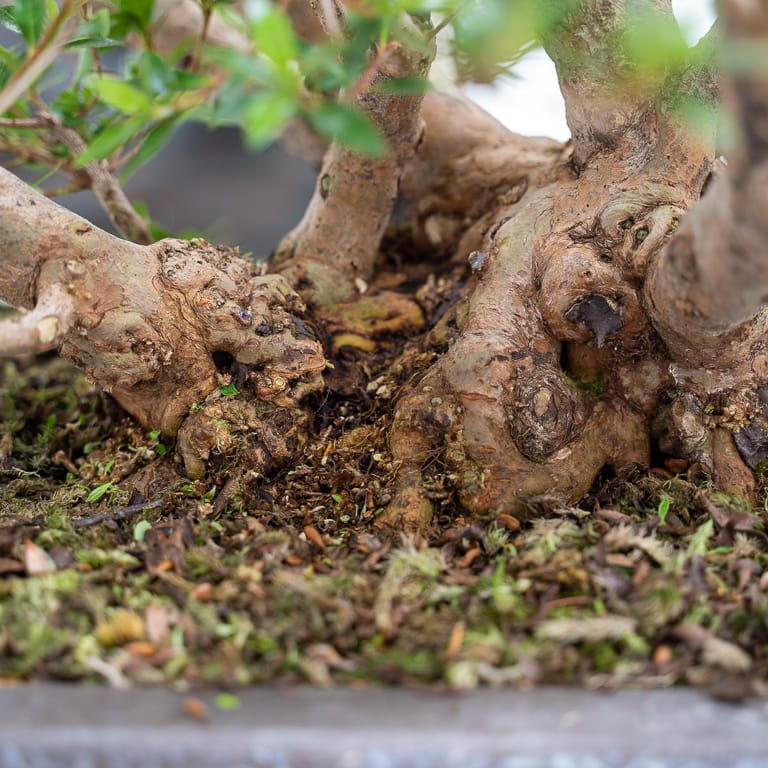Azalea care can seem puzzling at first, especially if you’re familiar with junipers or other hardy species. But with the right approach, keeping these flowering bonsai healthy is within reach. Here are the top five things you can do to keep your satsuki healthy.
1. Water more frequently
Satsuki azaleas produce fine roots that don’t respond well to drying out. Azalea roots can die back on a single hot day if they don’t get enough water. Once there is root dieback, it’s easy to overwater azaleas which can lead to additional problems.
The alternative is straightforward: if you see your azaleas wilting or drying out, water more frequently. When it’s 70 degrees F in my garden, I water my azaleas once per day and gently sprinkle or mist them 1-2 times. When it’s 85 degrees F, I’ll water twice and sprinkle or mist the trees an additional 3-4 times.
Selecting the right spot in your garden can help you keep satsuki hydrated. They like humidity and morning sun. They don’t like wind or direct afternoon sun when temps get above 65-70 degrees (some cultivars can handle more sun than others).
Using the right soil is just as important. Because azaleas prefer to grow in acidic media, the standard mix is 100% kanuma covered with a layer of yama goke or mountain moss. Small or shallow pots can make satsuki care challenging, so slightly larger or deeper pots are good options for providing satsuki with the water they need to thrive.
2. Remove flowers after blooming
You’ve likely heard this one before. When satsuki have finished blooming, remove the flowers to prevent the tree from producing seeds.
Here’s a satsuki on which most of the flowers have finished blooming.

Spent flowers on an exposed-root satsuki (Korin)
When removing the flower, make sure to remove the seed pod in addition to the spent petals. Removing the petals reduces habitat for azalea pests, and removing the seed pod lets the tree focus on producing new shoots.

Removing a spent flower

Azalea pistil – make sure to remove this when the flowers come off

Exposed root satsuki after removing the flowers
If, after cutting away the flowers, the foliage is still dense, this is a good time to thin the tree to make sure light reaches the lower branches.
3. Remove unnecessary growth
This one is true for most bonsai: if you see shoots that won’t be part of the future design – or support development as sacrificial branches – remove them as soon as possible.
Azaleas can produce new shoots anywhere along the trunk or branches. The more these shoots grow before they are removed, the larger the scars will be when you cut them off. Removing these shoots when they are just getting started will encourage the tree to invest in foliage on the branches you want to keep.

Multi-trunk satsuki with many shoots growing from the trunk (Osakazuki)

Close-up of the shoots growing from the trunk

After removing the shoots on the trunk

Azalea after clean up
4. Postpone work until your tree is growing well
Azaleas don’t respond well to work like styling or pruning unless they are healthy and growing vigorously. Let’s look at the signs of healthy azalea foliage.
Here’s a small shoot with healthy foliage.

Healthy satsuki foliage
Although the foliage looks great, the shoots themselves are short. If there are no signs of longer shoots on azaleas in development, it’s best to postpone wiring or heavy pruning.
The shoot below is a great example of the kind of growth to look for on developing satsuki bonsai.

Elongating shoot
Note the gaps between leaves on the shoot. When azalea shoots elongate, you have a good idea that the tree is ready to be worked on.
Extra-healthy branches may produce compound shoots. This is what you want to see when you are encouraging a branch or section of the trunk to thicken.

Robust shoot
The tree below is a good example of an azalea that’s healthy but not vigorous. I’ll wait until next year to start working on it.

Healthy exposed-root azalea (Hikari-no-Hikasa)
The following tree has dense foliage and many elongating shoots. This tree is ready to be worked on.

Healthy, and ready-to-be-worked-on, satsuki (Hi-no-Maru)
Postponing work until you are confident your satsuki will respond well is one of the keys to ensuring success with satsuki bonsai.
5. Watch out for insects and signs of fungus
The most important step for maintaining satsuki health is to check your trees carefully on a regular basis. Doing so will alert you to early signs of damage caused by insects or fungus.
Common azalea pests include thrips and lace bugs. Checking the underside of the leaves is the first place to look for them. If you see silvery foliage and/or black dots, you likely have one of these pests (see “Thrips and bonsai” for photos and treatment details).
Brown or black patches that appear in random patterns on leaf surfaces are a sign that you may be dealing with fungi. Brown or black leaf tips are commonly caused by too much or too little water, but they may be a sign of problems in the roots. If you see any of these symptoms, it’s time to investigate further by researching what you see online or taking a sample to a local nursery or garden center.
Summary
Unlike junipers or elms, satsuki azaleas may require extra care in your garden. Taking the above steps will address the most common causes of poor health in satsuki bonsai. To recap:
- Water more frequently
- Remove old flowers
- Remove unnecessary growth
- Only work on strong trees
- Look out for pests and fungus
Have additional tips you want to share? Note them in the comments below.
Redwood Empire Bonsai Society’s 36th Annual Bonsai Exhibit Opens This Weekend!
The Redwood Empire Bonsai Society is hosting their 36th annual exhibit this weekend, August 24-25, at the Santa Rosa Veterans Building in Santa Rosa, California. Hours are 10-5 Saturday and 10-4 Sunday.
For those who haven’t been, this is Northern California’s biggest bonsai event of the summer. Kathy Shaner will provide demos from 1-3 both days, and shoppers will enjoy the club sales, silent raffle and large vendor area.
I’ll be vending with a selection of tools, supplies, and trees, including a number of satsuki azalea bonsai – I hope to see you there!
Subscribe to Bonsai Tonight
New Posts Delivered Every Tuesday and Friday
Allen aigen says
I was under the impression that multiple shoots on a twig should be reduced to two. Is this not useful or not necessary?
Jonas Dupuich says
Hi Allen – yes, this is true if you plan to keep the branch. When growing the branch as a temporary way to thicken the trunk or another branch, you can keep all of the branchlets and remove them all together later.